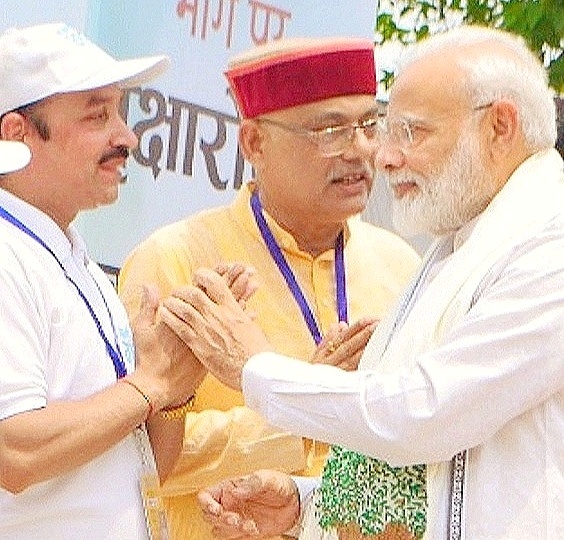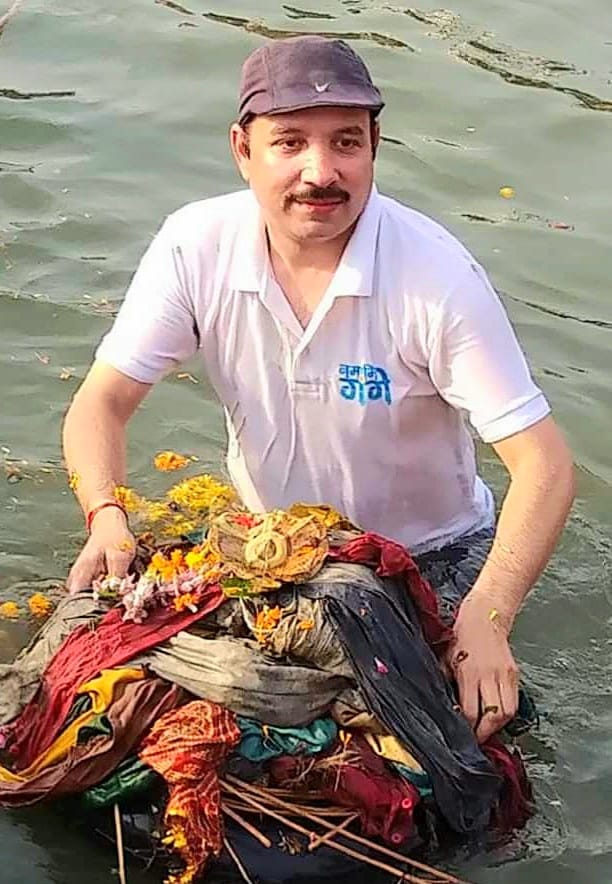Rajesh Shukla epitomizes unwavering dedication and relentless commitment to the cause of conserving and rejuvenating the sacred river Ganga. As the Convener of the Namami Gange Department in the BJP’s Kashi Region and the Co-coordinator of Namami Gange (Ganga Vichar Manch) in the Kashi Province, his leadership has been instrumental in driving impactful initiatives along the riverbanks of Varanasi.
For over a decade, Rajesh Shukla, inspired by the vision of Prime Minister Narendra Modi, has been at the forefront of efforts to serve Mother Ganga. His daily ritual of visiting the ghats, performing Aarti, and spearheading cleanliness drives has become synonymous with his tireless devotion. Despite challenges like the COVID-19 pandemic and flooding, his Bhagiratha-like endeavor to cleanse the Ganga has remained unwavering.
Shukla’s exemplary service hasn’t gone unnoticed. His efforts have garnered widespread acclaim, earning him recognition from various quarters. The Ministry of Jal Shakti, National Clean Ganga Mission, has appointed him as the State Coordinator of Namami Gange. Moreover, he holds key positions within the BJP’s Ganga-related departments, highlighting his influence and effectiveness in driving change.
Notably, Rajesh Shukla has received accolades from prominent figures including Union Minister Gajendra Singh Shekhawat and Chief Minister Yogi Adityanath, who honored him for his selfless service during the Prayag Kumbh. Prime Minister Narendra Modi himself has acknowledged and appreciated Shukla’s efforts, showcasing his work on social media platforms.
Shukla’s tireless dedication, coupled with his recognition as the “Hero of Ganga,” underscores his pivotal role in the conservation narrative. His story resonates not only with the people of Varanasi but also with the nation, as he continues to inspire others to join the noble cause of preserving the lifeline of India, the sacred river Ganga.
In a riveting discussion with Sudhanshu Srivastava, a Senior Journalist associated with The Interview Word, Rajesh Shukla delves into the intricacies of the Namami Gange Program. He shares how his involvement in the program was sparked by its inspiring mission to cleanse the Ganga, highlighting the significant role the government plays in this endeavor. Here are the pivotal takeaways from his interview.
Q: What insights can you share about your involvement with Namami Gange, shedding light on the program’s objectives and achievements?
A: Witnessing Prime Minister Narendra Modi actively participating in the Namami Gange Program by cleaning up waste at Assi Ghat was truly inspiring. Living close to Manikarnika Ghat, I regularly observed people taking from the sacred river without considering its sanctity, carelessly littering and polluting its waters. Motivated by this, I resolved to join Prime Minister Modi’s initiative and turn it into a collective effort.
From the inception of the “Ek Ghat Modi Ke Saath” movement in Varanasi in 2014, I committed myself to daily visits to various ghats, offering prayers to Mother Ganga, and encouraging others to join in cleaning the river. Over the past decade, my humble efforts have borne fruit. Today, I take pride in the progress we’ve made.
It’s crucial to recognize that Mother Ganga, symbolizing both life and the afterlife, deserves to be kept pristine. As the source of life, prosperity, blessings, and salvation, this sacred river must remain untainted.
Q: What inspired your vision to clean Mother Ganga from pollution and impurities?
A: Before 2014, I observed a concerning trend: the Ganga was being polluted by the actions of many individuals. There seemed to be a lack of awareness among people regarding the consequences of their actions on the river. People would casually stroll along its banks, heedless of the impact of their celebrations and the subsequent disposal of waste into the Ganga. Even after performing last rites, it was customary for people to discard old garments and other items into the river, believing it would aid in the salvation of the departed soul. Additionally, worshippers visiting temples near the Ghats would thoughtlessly discard leftover flowers and offerings into the Ganga, further contributing to its pollution.
Recognizing the severity of this issue, I endeavored to raise awareness about the detrimental effects of such mindless behavior on our sacred river. Consequently, I became actively involved in the Namami Gange initiative, dedicating myself wholeheartedly to the cause of ensuring the cleanliness and sanctity of the Ganga.
Q: What is the current number of individuals actively participating in this noble initiative alongside you?
A: In our endeavor to clean the Ganga, there is a committed cohort of approximately 10 to 20 individuals who actively collaborate with me. Nevertheless, the broader scope of our organization encompasses more than a hundred dedicated members. These individuals, spanning various demographics, including both men and women, selflessly contribute their time and effort to the Ganga’s purification alongside fulfilling their household duties. Their dedication remains unwavering as they persistently engage in the ongoing cleanup activities.
Our outreach efforts extend inclusively to diverse groups within society, encompassing Brahmins, shopkeepers, photographers, and others. We underscore the vital significance of maintaining the river’s cleanliness, as it serves as the lifeblood sustaining their existence and livelihoods. Consequently, it becomes imperative for each member of these communities to shoulder the responsibility of ensuring the Ganga’s pristine condition, thereby safeguarding its ecological integrity for future generations.
Q: What level of support does the administration provide you for initiatives aimed at cleaning the Ganga?
A: In tasks as extensive as this, administration plays a pivotal role. My approach involves capturing activities near the ghats through photos and videos, swiftly sharing them with local authorities for immediate attention. This prompts the administration to take prompt action, exemplified by their swift response to issues like sewage entering the river. Unlike before 2014, when few sewage treatment plants existed in the Ganga basin, today there are nearly 6,000 MLD plants, with 4,500 MLD already operational.
The government’s responsibility encompasses constructing STPs, conducting bankside plantations, and enhancing local areas with parks, all under the Namami Gange Program across five states. This contrasts sharply with the past, where such initiatives were lacking. Presently, the government displays remarkable responsiveness, addressing Ganga cleanup challenges through various means, from awareness campaigns to STP construction, yielding tangible results on the ground.
Q: What key message would you like to convey to the readers of The Interview World?
A: In every corner of the world, let’s prioritize water conservation and the restoration of our water bodies, be it ponds, lakes, or rivers. Each of us must personally commit to this cause and rally others in our communities to join in, emphasizing the importance of preserving every precious drop of water.
We must pledge to refrain from polluting our water sources with garbage. It is our collective duty to maintain our health, and this begins with ensuring the cleanliness of our water bodies becomes an integral part of our daily lives. Join me in supporting our Prime Minister’s initiative to conserve water, cleanse our water bodies, and spread awareness throughout our society. Together, let’s work hand in hand to make this initiative a resounding success.



